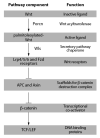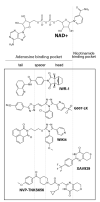Chemical Disruption of Wnt-dependent Cell Fate Decision-making Mechanisms in Cancer and Regenerative Medicine
- PMID: 26310918
- PMCID: PMC4697282
- DOI: 10.2174/0929867322666150827094015
Chemical Disruption of Wnt-dependent Cell Fate Decision-making Mechanisms in Cancer and Regenerative Medicine
Abstract
Cell-to-cell signaling molecules such as the Wnt proteins that directly influence the expression of cell-type specific transcriptional programs are essential for tissue generation in metazoans. The mechanisms supporting cellular responses to these molecules represent potential points of intervention for directing cell fate outcomes in therapeutic contexts. Small molecules that modulate Wnt-mediated cellular responses have proven to be powerful probes for Wnt protein function in diverse biological settings including cancer, development, and regeneration. Whereas efforts to develop these chemicals as therapeutic agents have dominated conversation, the unprecedented modes-of-action associated with these molecules and their implications for drug development deserve greater examination. In this review, we will discuss how medicinal chemistry efforts focused on first in class small molecules targeting two Wnt pathway components--the polytopic Porcupine (Porcn) acyltransferase and the cytoplasmic Tankyrase (Tnks) poly-ADP-ribosylases--have contributed to our understanding of the druggable genome and expanded the armamentarium of chemicals that can be used to influence cell fate decision-making.
Figures






Similar articles
-
Disruption of Wnt/β-Catenin Signaling and Telomeric Shortening Are Inextricable Consequences of Tankyrase Inhibition in Human Cells.Mol Cell Biol. 2015 Jul;35(14):2425-35. doi: 10.1128/MCB.00392-15. Epub 2015 May 4. Mol Cell Biol. 2015. PMID: 25939383 Free PMC article.
-
Chemical Modulation of WNT Signaling in Cancer.Prog Mol Biol Transl Sci. 2018 Jan;153:245-269. doi: 10.1016/bs.pmbts.2017.11.008. Epub 2018 Jan 8. Prog Mol Biol Transl Sci. 2018. PMID: 29389519 Review.
-
Small-molecule inhibitors of Wnt signaling pathway: towards novel anticancer therapeutics.Future Med Chem. 2015;7(18):2485-505. doi: 10.4155/fmc.15.159. Epub 2015 Dec 16. Future Med Chem. 2015. PMID: 26670195 Free PMC article. Review.
-
Recent Advances in Developmental Signaling Pathway Inhibitors for the Treatment of Cancer.Curr Med Chem. 2015;22(35):4031-2. doi: 10.2174/092986732235151126193822. Curr Med Chem. 2015. PMID: 26630931 No abstract available.
-
Discovering small molecules as Wnt inhibitors that promote heart regeneration and injury repair.J Mol Cell Biol. 2020 Jan 22;12(1):42-54. doi: 10.1093/jmcb/mjz023. J Mol Cell Biol. 2020. PMID: 30925593 Free PMC article.
Cited by
-
Tankyrase inhibitors suppress hepatocellular carcinoma cell growth via modulating the Hippo cascade.PLoS One. 2017 Sep 6;12(9):e0184068. doi: 10.1371/journal.pone.0184068. eCollection 2017. PLoS One. 2017. PMID: 28877210 Free PMC article.
-
Development of a triazole class of highly potent Porcn inhibitors.Bioorg Med Chem Lett. 2016 Dec 15;26(24):5891-5895. doi: 10.1016/j.bmcl.2016.11.012. Epub 2016 Nov 11. Bioorg Med Chem Lett. 2016. PMID: 27876319 Free PMC article.
-
ERAD-dependent control of the Wnt secretory factor Evi.EMBO J. 2018 Feb 15;37(4):e97311. doi: 10.15252/embj.201797311. Epub 2018 Jan 29. EMBO J. 2018. PMID: 29378775 Free PMC article.
-
Delivery of the Porcupine Inhibitor WNT974 in Mice.Methods Mol Biol. 2016;1481:111-7. doi: 10.1007/978-1-4939-6393-5_12. Methods Mol Biol. 2016. PMID: 27590157 Free PMC article.
-
Installation of a cancer promoting WNT/SIX1 signaling axis by the oncofusion protein MLL-AF9.EBioMedicine. 2019 Jan;39:145-158. doi: 10.1016/j.ebiom.2018.11.039. Epub 2018 Dec 6. EBioMedicine. 2019. PMID: 30528456 Free PMC article.
References
-
- Clevers H. The intestinal crypt, a prototype stem cell compartment. Cell. 2013;154(2):274–284. - PubMed
-
- Korinek V, Barker N, Moerer P, van Donselaar E, Huls G, Peters PJ, Clevers H. Depletion of epithelial stem-cell compartments in the small intestine of mice lacking Tcf-4. Nat Genet. 1998;19(4):379–383. - PubMed
Publication types
MeSH terms
Substances
Grants and funding
LinkOut - more resources
Full Text Sources
Other Literature Sources

